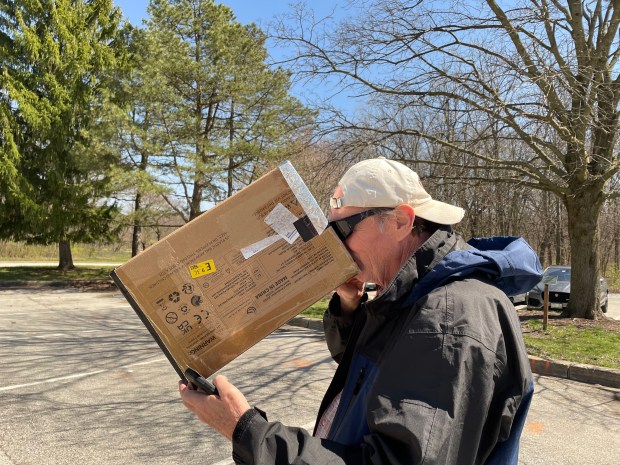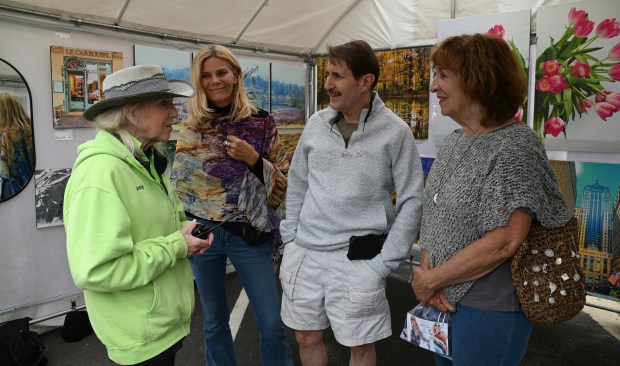Deep in the Pulaski Woods Forest Preserve in Willow Springs, around 50 southland residents settled on the lawn outside of the Little Red Schoolhouse Nature Center and turned their eyes to the sky.
Retirees, parents with small children and science fans of all ages came out to celebrate the rare solar eclipse that passed through Illinois Monday afternoon. While only far southern parts of the state like Carbondale experienced full coverage of the sun by the moon, the near south suburbs of Chicago saw about 94% of coverage, according to Adler Planetarium staff and Rebecca Moss, who works for the Cook County forest preserves.
At around 2 p.m., the moon’s passing over the sun was witnessed by the crowd gathered in Willow Springs not only by looking up through the special glasses provided by Adler Planetarium, but also in the environment. For about 20 minutes, the daylight dipped to an early dusk and the temperature seemed to drop a few degrees.
Morgan Park resident Aina Holmes, 69, zipped up her jacket, put her eclipse glasses on, looked up and smiled. This is what she came for.
“I want to be a part of it,” she said. “I want to see it. I want to feel it. I want to appreciate it.”
Nearby, three children ate snacks and rolled in the grass. Jennifer Hawk brought her children out to the forest preserve to see their first solar eclipse. One of the children was not born when a solar eclipse passed through southern Illinois in 2017, and the other two kids didn’t remember it.
“What does it kind of look like?” Hawk asked her kids.
“A cookie with a bite out of it!” said 11-year old Abigail as she demonstrated the shape with a chomp at a Chips Ahoy! chocolate chip cookie.
Unlike Abigail and her siblings, Monday wasn’t the first time Brian Sarna’s had witnessed a solar eclipse. He said when he was in grade school sometime in the 1960s, he and his friends went out to their lawn to check out a partial eclipse in Chicago. Sarna said solar eclipse glasses were not as accessible at the time, so he and his friends resorted to making a makeshift viewer by using a cardboard box, a sheet of white paper, some duct tape and tin foil. If done correctly, the reflection of the eclipse shows up on the paper.
But Sarna made a mistake. He had made the hole too big and the box was not the right size.
“This whole time, I was waiting for this thing and it was such a letdown,” he said, recalling that day some 60 years ago. “So when it came this time, I wanted to do it again and I’m really happy.”
He walked around the parking lot showing other spectators his flawlessly designed box.
“You gotta get in there and look at it,” Sarna instructed.
On the sheet of paper at the back of the box appeared the small sliver of light that shone past the moon’s.
For a more precise view of the eclipse, Moss, who works in education outreach for the Cook County forest preserves, set up two large telescopes. She used the sun’s shadow to line up the viewfinder and then twisted the focus knob. Guests lined up to take a look.
“I am fascinated to be able to do something that humans have done for a millennium: to watch an eclipse,” said 68-year old Deborah Bennett of Chicago.
Bennet sat on a blanket with her friend, Aina Holmes, and pondered. She thought about previous generations of homo sapiens and wondered “what humans over time have believed these kind of phenomena portend.”
She’s not sure she knows the answer yet.
hsanders@chicagotribune.com





